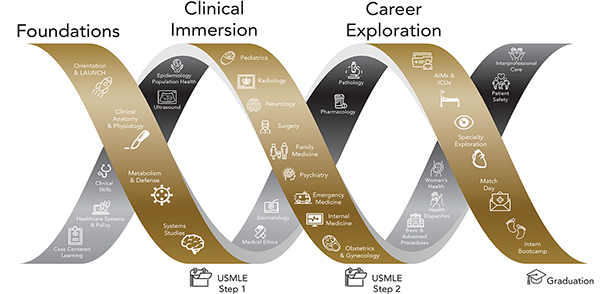Nathan Hatch, Ph.D. President, Wake Forest University
The art of medicine is still taught at Wake Forest School of Medicine in ways that our alumni would recognize. But the science of healthcare is evolving — very fast! As medicine advances with new discoveries and technology, medical education must keep pace to prepare physicians who will thrive in the 21st-century. That’s the impetus behind Wake Forest School of Medicine’s new curriculum: Wake Ready! Basic science and clinical studies are fully integrated, with a focus not just on disease but on wellness and prevention. We integrate pedagogical methods that develop professionalism, critical thinking, problem solving and active learning skills.
Wake Forest School of Medicine graduates have the knowledge, skills, attitudes and habits that make them successful for residency as Day 1 Interns. Our graduates are the kind of professionals whom we would trust to take care of our family members.
Learning in Phases
The Wake Ready! curriculum is divided into three phases to better prepare medical students for the next step in their training.
Phase one: Foundations. Students obtain foundational knowledge of the sciences needed to be a successful doctor, such as anatomy, biochemistry, microbiology and immunology, as well as key components of clinical medicine, including patient-doctor communication, bioethics and population health. Longitudinal ultrasound training begins in Foundations.
Phase two: Clinical Immersion. Building on the foundations from the first phase of the curriculum, students apply basic and advanced procedural knowledge and problem-solving skills. These practice-based learning opportunities are experienced through clerkships in Emergency Medicine, Family Medicine, Internal Medicine, OB-GYN, Psychiatry, Neurology, Pediatrics and Internal Medicine.
Phase three: Career Exploration. The final phase focuses on individualized clinical training, offering the flexibility for students to further develop their core clinical interests with a focus on their future career plans.
Upon completion of the curriculum, graduates are more than prepared for their next step.
“I look back at my medical school experience and realize that Wake Forest did a fantastic job preparing me for residency,” Chris Stem, MD ’15, wrote to Marcia Wofford, MD, associate dean of student affairs, after a month of his pediatric residency at Medical University of South Carolina.

Innovative Courses, Integrated in All Aspects
Integrated throughout the phases of the curriculum, courses provide the catalyst for achieving students’ goals in medicine. The Ultrasound Curriculum is a key example of offerings not available at all medical schools.Ultrasound training builds confidence in using a technology that’s a fundamental part of modern medicine. In phase one, ultrasound courses reinforce key concepts in anatomy and physiology; in phase two, students build competency by using the technology in clerkships; and in phase three, students have the option of a point-of-care ultrasound elective.
“Teaching this skill is huge for enhancing student learning, applying knowledge differently and improving patient safety; it’s critical for physicians of the future,” Mary Claire O’Brien, MD, senior associate dean for healthcare education, professor of emergency medicine, and professor of social sciences and health policy, says.
A New Environment for a New Curriculum
The opening of the Bowman Gray Center for Medical Education has provided an ideal environment for teaching 21st-century medicine and is a perfect complement to the Wake Ready! curriculum.The building includes an expanded anatomy lab and a large clinical skills center with 20 simulated patient rooms, as well as simulated settings to represent an emergency room, operating room and an intensive care unit.
Located in downtown Winston-Salem’s Wake Forest Innovation Quarter, the Medical Education Building also features technology that students will experience in clinical settings and spaces that encourage interaction and multidisciplinary learning.
“As educators, we’re tasked not only with instructing our students but inspiring them as well,” Timothy Peters, MD, associate professor of pediatrics, says. “That’s one of the most exciting things about our new medical education building. It’s a physical reflection of an aspirational curriculum. The thoughtful design manifests our commitment to team building and to education using cutting-edge technology.”
